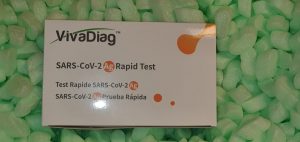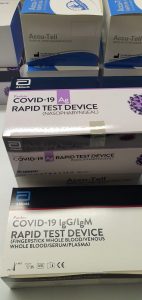Pilz et al. (Fluids Barriers CNS 17:7; 2020) investigated how CSF CXCL13 concentrations are influenced by CXCL13 serum concentrations and blood-CSF barrier (BCSFB) perform, evaluating the affect of serum CXCL13 ranges and Qalbumin (CSF albumin/serum albumin) on CSF CXCL13 amongst sufferers with CNS irritation categorized as CXCL13 unfavourable, low, medium, or excessive.
Among all CXCL13 teams, their outcomes confirmed no correlation between CSF CXCL13 concentrations and serum CXCL13 or Qalbumin. The authors argue that, in distinction to different proteins, CXCL13 passage throughout the BCSFB doesn’t happen, no matter BCSFB perform, and is as an alternative solely influenced by intrathecal manufacturing.
In distinction to the authors’ findings, in our research together with each non-inflammatory neurological issues (NIND; n = 62) and a number of sclerosis (MS) sufferers we noticed a big correlation between serum CXCL13 concentrations and CSF CXCL13 concentrations.
We evaluation a number of observations which can underlie these contrasting outcomes, together with (1) the affect of serum CXCL13 concentrations on CSF CXCL13 in sufferers with decrease intrathecal CXCL13 manufacturing and thus decrease CXCL13 concentrations (i.e. NIND and MS), (2) the proposed diffusion dynamics of the small molecule CXCL13 throughout the BCSFB, and (3) differing definitions of unfavourable versus elevated CSF CXCL13 concentrations decided by an assay’s relative sensitivity. In conclusion, we argue that for sufferers with reasonably elevated CSF CXCL13 concentrations, serum CXCL13 concentrations affect CSF CXCL13 ranges, and thus the suitable corrections together with incorporation of CSF/serum ratios and Qalbumin values must be utilized.
The Specific Judo Training Program Combined With the Whole Body Cryostimulation Induced an Increase of Serum Concentrations of Growth Factors and Changes in Amino Acid Profile in Professional Judokas
This research aimed to guage the impact of a selected coaching program, supported by 10 classes of complete physique cryostimulation, on progress elements concentrations, amino acids profile and motor skills in skilled judokas. Ultimately, twelve athletes took half in the research. They had been randomly assigned to the cryostimulation group (CRY, n = 6) or the management group (CON, n = 6). During 2 weeks of the judo coaching program, the CRY group carried out 10 cryo-sessions (3-min, at a temperature of -110°C) and the CON group rested passively.
Anthropometric measurements, a energy take a look at, the Special Judo Efficiency Test (SJET) had been assessed 2 days earlier than and after the judo coaching program. Blood samples had been collected at relaxation, 1 h after the primary and the second SJET and 1 h after the primary and the final cryo-session to ascertain progress elements and amino acid concentrations.
Lactate degree was measured earlier than, instantly after and 1 h after the primary and the second SJET. The utilized intervention resulted in a big improve of resting concentrations of brain-derived neurotrophic issue (from 10.23 ± 1.61 to 15.13 ± 2.93 ng⋅ml-1; p = 0.01) and insulin-like progress issue 1 (IGF-1; from 174.29 ± 49.34 to 300.50 ± 43.80 pg⋅ml-1; p = 0.00) in the CRY group.

A totally different response was registered 1 h immediately put up SJET in the CRY group (a big improve of IGF-1, interleukin 15 and irisin: p = 0.01; p = 0.00; p = 0.03). Additionally, the numerous drop of proline and leucine concentrations in the CRY group was obtained. Athletes’ efficiency remained unchanged in each teams. However, topics perceived constructive adjustments induced by the intervention – in a roundabout way after cryostimulation however in response to the particular coaching workload. The improve of progress elements concentrations and the advance of amino acid profile (proline and leucine) contributed to sustaining a excessive degree of muscle perform.
Multivariate Investigation of Toxic and Essential Metals in the Serum from Various Types and Stages of Colorectal Cancer Patients
Colorectal most cancers (CRC) is at the moment one of the crucial frequent malignant neoplasms, rating third in incidence and 2nd in mortality each in the USA and internationally. The pathogenesis of CRC is a posh interplay between genetic susceptibility and environmental elements resembling publicity to metals. Therefore, the current research was meant to evaluate the imbalances in the concentrations of chosen important/poisonous parts (Pb, Cr, Fe, Zn, As, Cd, Cu, Se, Ni, and Hg) in the serum of newly identified colorectal carcinoma sufferers (n = 165) in comparability with counterpart controls (n = 151) by atomic absorption spectrometry after wet-acid digestion technique.
Serum carcinoembryonic antigen (CEA) of the CRC sufferers was decided utilizing immunoradiometric technique. Body mass index (BMI) which is a longtime threat issue for CRC was additionally calculated for sufferers and wholesome controls. Conversely, common Ni (2.721 μg/g), Cd (0.563 μg/g), As (0.539 μg/g), and Pb (1.273 μg/g) ranges had been considerably elevated in the serum of CRC sufferers in comparison with the wholesome donors, whereas the typical Se (7.052 μg/g), Fe (15.67 μg/g), Cu (2.033 μg/g), and Zn (8.059 μg/g) concentrations had been elevated in controls.
The correlation coefficients between the weather in the cancerous sufferers demonstrated considerably dissimilar communal relationships in contrast with the wholesome topics. Significant variations in the basic ranges had been additionally confirmed for CRC varieties (major colorectal lymphoma, gastrointestinal stromal tumor, and adenocarcinoma) and CRC levels (stage-I, stage-II, stage-III, and stage-IV) among the many sufferers. Majority of the weather demonstrated perceptible disparities in their ranges based mostly on dietary, habitat, gender, and smoking habits of the malignant sufferers and wholesome topics.
[Linking template=”default” type=”products” search=”SAA4 antibody” header=”3″ limit=”199″ start=”4″ showCatalogNumber=”true” showSize=”true” showSupplier=”true” showPrice=”true” showDescription=”true” showAdditionalInformation=”true” showImage=”true” showSchemaMarkup=”true” imageWidth=”” imageHeight=””]
Multivariate strategies revealed noticeably divergent apportionment among the many poisonous/important parts in the cancerous sufferers than the wholesome counterparts. Overall, the research confirmed considerably divergent distribution and associations of the important and poisonous elemental ranges in the serum of the CRC sufferers in comparability with the wholesome donors.



